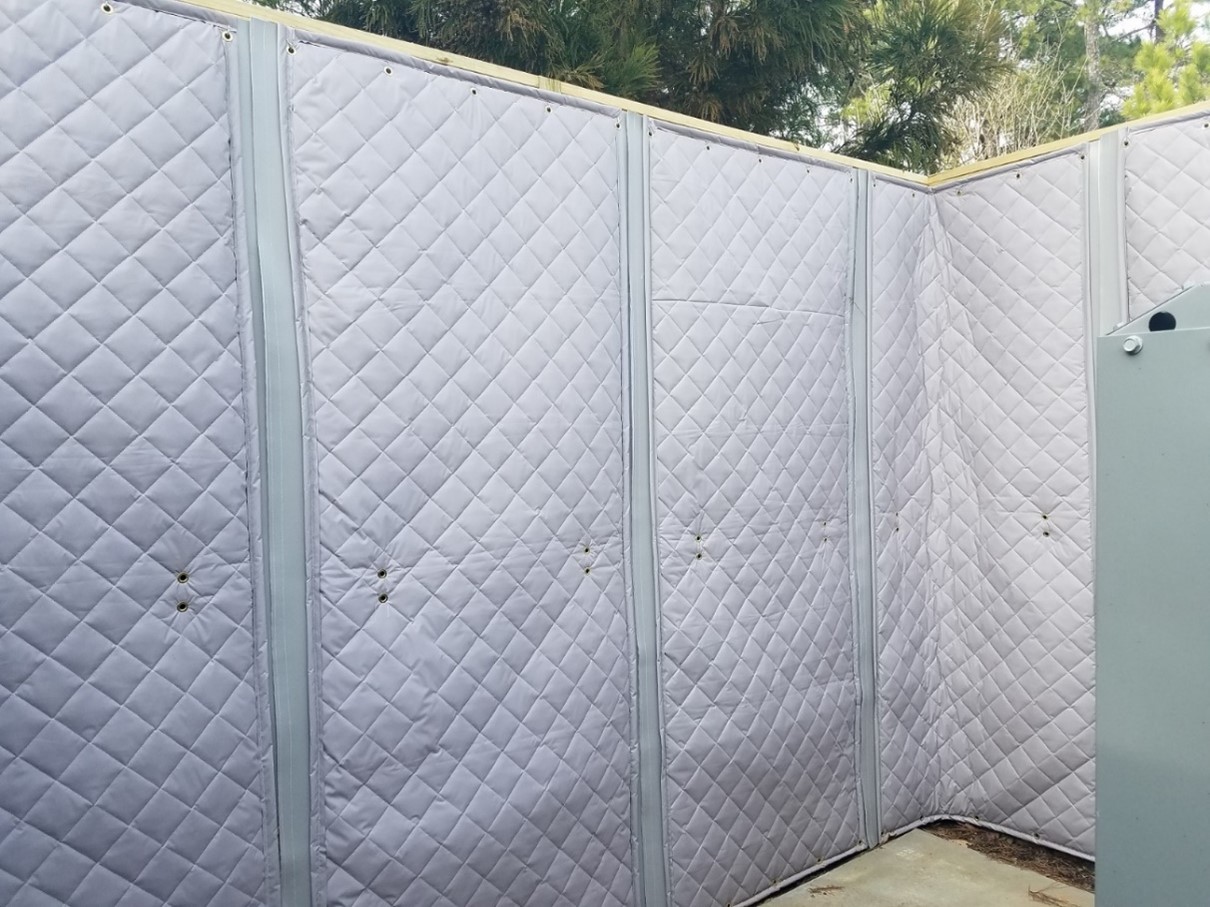Are you tired of dealing with noise pollution in your backyard? Want to create a peaceful outdoor space where you can relax and enjoy some tranquility? Well, have you ever considered adding insulation with sound barrier fencing? It’s a great solution to minimize noise and create a more peaceful environment. In this article, we’ll delve into the topic of adding insulation with sound barrier fencing and explore the various benefits and considerations you need to keep in mind. Whether you’re looking to block out traffic noise, neighborhood chatter, or even the sound of your own air conditioning unit, we’ve got you covered!
When it comes to creating a quieter outdoor space, sound barrier fencing can make a significant difference. These specialized fences are designed to block and absorb sound, reducing noise pollution from entering your backyard. Not only can they provide a more peaceful environment, but they also add an aesthetic appeal to your property. You can choose from a variety of materials and styles to match your personal taste and complement your existing landscape. In our upcoming article, we’ll explore the different types of sound barrier fencing, their installation process, and how to maintain them for long-lasting performance. So, stay tuned and let’s dive deeper into the world of adding insulation with sound barrier fencing to reclaim your peaceful oasis!
Adding Insulation with Sound Barrier Fencing
Are you tired of the constant noise pollution in your surroundings? Do you value your privacy and wish to enhance it? Are you looking to increase the value of your property? If you answered yes to any of these questions, then adding insulation with sound barrier fencing is the solution you’ve been waiting for. In this article, we will explore the many benefits of sound barrier fencing, the different types of insulation available, installation processes, maintenance tips, common soundproofing issues and solutions, the role of vegetation in soundproofing, cost analysis, building codes and regulations, case studies, environmental impact, and the choice between DIY or professional installation. Let’s dive in and discover how you can enjoy a peaceful and quiet environment with sound barrier fencing.
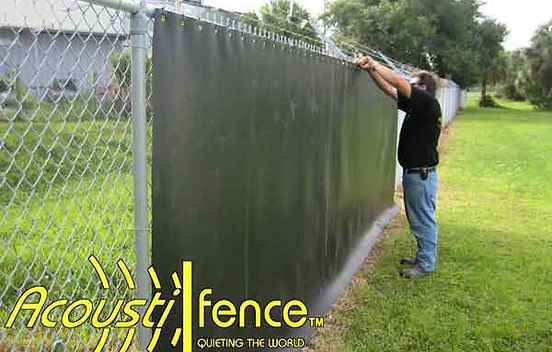
Benefits of Adding Insulation with Sound Barrier Fencing
Reduced Noise Pollution
One of the most immediate and noticeable benefits of installing sound barrier fencing is the reduction of noise pollution. Whether you live near a busy road, a construction site, or in a noisy neighborhood, the constant exposure to excessive noise can be detrimental to your mental and physical well-being. Sound barrier fencing creates a barrier between you and the source of the noise, effectively reducing its impact and allowing you to enjoy a quieter and more peaceful environment.
Improved Privacy
Privacy is a valuable commodity, and sound barrier fencing can significantly enhance it. By adding insulation to your fence, you create an additional layer of protection from prying eyes and unwanted attention. Whether you’re relaxing in your backyard, hosting a gathering, or simply enjoying a moment of solitude, sound barrier fencing ensures that your activities remain hidden from view and uninterrupted by outside disturbances.
Enhanced Property Value
Investing in sound barrier fencing with insulation can significantly increase the value of your property. Potential homebuyers and appraisers alike recognize the importance of a peaceful and quiet living environment. By implementing soundproofing measures, you make your property more attractive, especially in areas with high noise levels or busy traffic. A well-insulated fence demonstrates that you have taken steps to ensure a comfortable and enjoyable living space, which can positively impact the perceived value of your property.
Types of Insulation for Sound Barrier Fencing
When it comes to sound barrier fencing, there are three main types of insulation to choose from:
Fiberglass Insulation
Fiberglass insulation is a popular choice for soundproofing fences due to its excellent sound-absorbing properties. Made from tiny glass fibers, this type of insulation effectively reduces noise transmission by trapping sound waves within its network of fibers. Fiberglass insulation is lightweight, easy to install, and resistant to moisture, making it suitable for both indoor and outdoor applications.
Rockwool Insulation
Rockwool insulation, also known as mineral wool or stone wool, is another commonly used material for soundproofing fences. Made from natural stone and recycled slag, rockwool insulation provides excellent sound absorption and thermal insulation properties. It is particularly effective at reducing lower frequency sounds and is also fire-resistant, making it a safe choice for sound barrier fencing.
Cellulose Insulation
Cellulose insulation is an eco-friendly option for sound barrier fencing. Made from recycled paper and fabric materials, this type of insulation is treated with fire-retardant chemicals to ensure safety. Cellulose insulation is highly effective at reducing noise transmission and also offers good thermal insulation properties. It is easy to install and can be blown or packed into the fence panels, providing a seamless soundproofing solution.
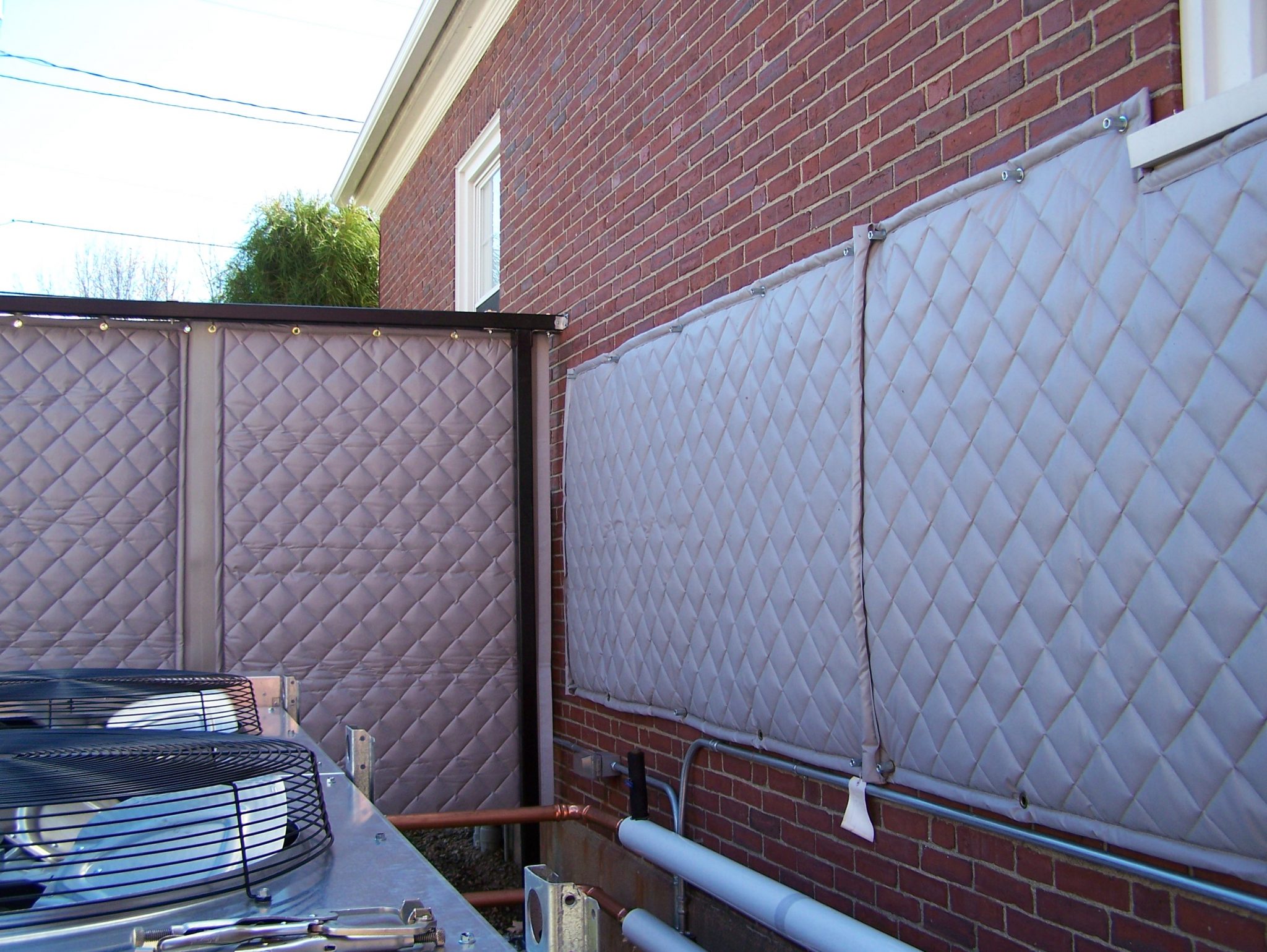
Factors to Consider when Choosing Insulation
Before choosing the insulation for your sound barrier fencing, there are several factors to consider:
Sound Transmission Class (STC) Rating
The Sound Transmission Class (STC) rating is a measure of how well a material can block sound. The higher the STC rating, the better the material is at reducing noise transmission. When selecting insulation for sound barrier fencing, consider the noise levels in your area and choose an insulation material with a high STC rating for maximum soundproofing benefits.
Density and Thickness
The density and thickness of the insulation material play a crucial role in its sound-absorbing capabilities. Thicker and denser materials are generally more effective at reducing noise transmission. Consider the specific noise sources in your environment and choose an insulation material that matches the required density and thickness to combat those specific frequencies.
Fire Safety
Fire safety is an important consideration when choosing insulation for sound barrier fencing. Look for insulation materials that are treated with fire-retardant chemicals or are naturally fire-resistant. This ensures that your soundproofing measures do not compromise the safety of your property.
Installation Process for Sound Barrier Fencing
Installing sound barrier fencing with insulation requires careful planning and execution. Here’s a step-by-step guide to help you through the installation process:
Preparing the Fence Panels
First, prepare your fence panels by cleaning and inspecting them for any damages. Repair or replace any broken or deteriorated panels before proceeding with the insulation installation.
Applying Insulation
Once the fence panels are ready, measure and cut the insulation material to fit the dimensions of each panel. Ensure a snug fit by pressing the insulation firmly against the panels. Use adhesive or nails to secure the insulation in place, ensuring it covers the entire surface area without any gaps.
Securing Insulation in Place
To prevent the insulation from shifting or falling out, secure it in place by attaching an additional layer of plywood or MDF board to each panel. This not only provides added support but also helps create an airtight seal for maximum soundproofing effectiveness.
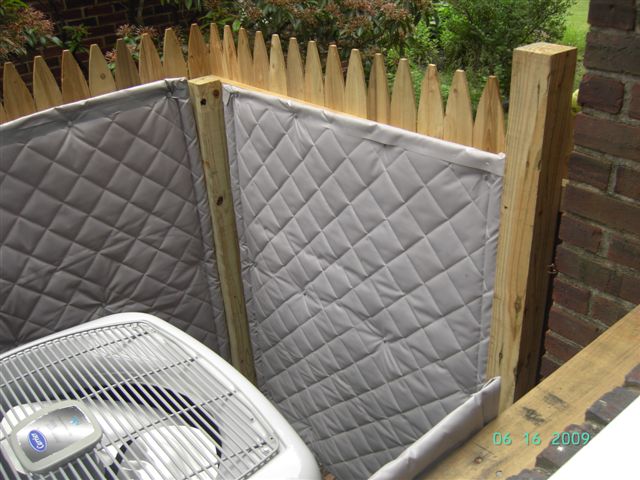
Maintaining Sound Barrier Fencing
To ensure the longevity and effectiveness of your sound barrier fencing, regular maintenance is essential. Here are some tips for maintaining your soundproof fence:
Regular Cleaning
Clean your sound barrier fence regularly to remove dirt, dust, and debris that may accumulate over time. Use a gentle detergent, water, and a soft brush to scrub the fence panels. Rinse thoroughly and allow them to air dry before reapplying any protective coatings or treatments.
Inspecting for Damages
Periodically inspect your fence for any signs of damage, such as cracks, gaps, or loose insulation. Repair or replace any damaged components promptly to maintain the soundproofing effectiveness of your fence.
Replacing Damaged Insulation
If you notice any damaged insulation, such as tears, mold growth, or compression, replace it immediately. Damaged insulation can compromise the soundproofing properties of your fence and may require professional assistance to ensure proper installation.
Common Soundproofing Issues and Solutions
While sound barrier fencing is an effective method to reduce noise pollution, certain issues may arise. Here are some common soundproofing issues and their solutions:
Gaps and Air Leaks
Gaps and air leaks in your sound barrier fencing can significantly reduce its effectiveness at blocking noise. Inspect your fence regularly and seal any gaps or openings using acoustic caulk or weatherstripping. This will create an airtight barrier and prevent sound leakage.
Inadequate Insulation Thickness
If you find that your sound barrier fence is not effectively blocking the desired noise levels, inadequate insulation thickness may be the issue. Consider adding an additional layer of insulation or upgrading to a denser material to improve your fence’s soundproofing capabilities.
Reverberation
Reverberation occurs when sound waves bounce off hard surfaces, causing echoes and amplifying the noise. To minimize reverberation, consider adding sound-absorbing materials to the surrounding area, such as acoustic panels, curtains, or vegetation, to absorb and dampen sound waves.
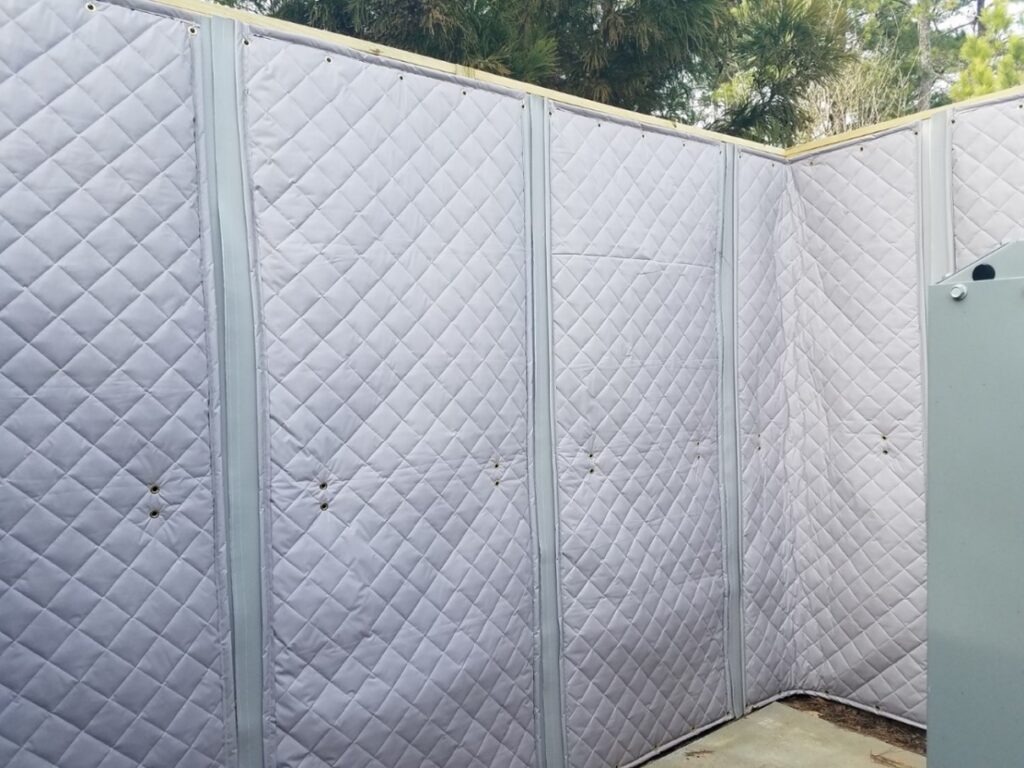
Soundproofing with Vegetation
In addition to insulation, vegetation can also play a significant role in reducing noise pollution. Here are two ways to incorporate vegetation into your soundproofing efforts:
Planting Trees as Natural Sound Barriers
Strategically planting trees along the perimeter of your property can provide a natural sound barrier. Trees with dense foliage, such as evergreens, can absorb and block sound waves, making your outdoor space quieter and more peaceful. Additionally, trees offer other benefits, such as improved air quality, aesthetics, and shade.
Using Shrubs and Bushes for Noise Reduction
As an alternative to trees, shrubs and bushes can also serve as effective noise reduction tools. Planting dense shrubbery along the fence line can help absorb sound waves and create an additional layer of soundproofing. Choose varieties with thick foliage and consider mixing different types of shrubs for maximum effectiveness.
Cost Analysis of Sound Barrier Fencing with Insulation
Before embarking on a sound barrier fencing project, it’s essential to consider the associated costs. Here are some cost factors to consider:
Material Costs
The cost of materials for sound barrier fencing will vary depending on the type of insulation chosen, the size of your fence, and any additional components required for installation. Generally, fiberglass insulation is the most cost-effective option, while rockwool and cellulose insulation may be slightly more expensive.
Labor Costs
If you choose to hire professional contractors for the installation, labor costs will come into play. The complexity of the project, the size of your fence, and the experience of the contractors will all affect the final labor cost. It’s advisable to obtain multiple quotes from reputable professionals to ensure you get the best value for your investment.
Long-term Energy Savings
An often overlooked cost-saving aspect of sound barrier fencing with insulation is the potential for long-term energy savings. Properly insulated fences can help regulate the temperature inside your property, reducing the need for excessive heating or cooling. This, in turn, can result in lower energy bills and long-term savings.
Building Codes and Regulations for Sound Barrier Fences
When installing sound barrier fencing, it’s crucial to comply with local building codes and regulations. Here are some key considerations:
Height Restrictions
Check with your local municipality or homeowners association to determine any height restrictions that may apply to your fence. Generally, there are specific limitations on the maximum height of fences, which can vary depending on the location of your property.
Permit Requirements
In some jurisdictions, permits may be required for the installation of sound barrier fences. Research the permit requirements of your area and ensure you obtain the necessary approvals before commencing the installation. Failure to do so may result in fines or the need to remove the fence.
Neighborhood Approval
If you live in a neighborhood with strict rules and regulations regarding fences, it’s essential to seek approval from the appropriate authorities or homeowner’s association. This will ensure that your sound barrier fence meets the aesthetic standards and guidelines set forth by your community.
Case Studies: Successful Soundproofing Projects
To showcase the effectiveness of sound barrier fencing with insulation, let’s explore some successful case studies:
Residential Settings
In a residential neighborhood located near a busy highway, the residents experienced high levels of noise pollution. By installing sound barrier fencing with rockwool insulation, the noise levels were significantly reduced, creating a quieter and more enjoyable living environment. The enhanced privacy also proved beneficial, allowing residents to enjoy their outdoor spaces without feeling exposed.
Commercial Establishments
A restaurant situated in a bustling city center faced challenges with noise from nearby construction sites and heavy traffic. By installing fiberglass insulation in their outdoor dining area’s perimeter fence, the noise was effectively blocked, providing a serene and pleasant atmosphere for guests. This resulted in increased customer satisfaction and repeat business.
Outdoor Event Spaces
An outdoor event venue located near a railway track sought to address noise issues affecting their events. By incorporating vegetation and sound barrier fencing with cellulose insulation, they successfully created a buffer zone that reduced train noise and ensured a more enjoyable experience for both event organizers and attendees.
Environmental Impact of Sound Barrier Fencing
As an environmentally conscious solution, sound barrier fencing with insulation offers several positive impacts:
Eco-friendly Insulation Options
Many insulation materials used for sound barrier fencing are eco-friendly and made from recycled or sustainable materials. Choosing these materials helps reduce waste and the overall environmental footprint.
Reduced Noise Pollution Effects on Wildlife
Excessive noise pollution can have adverse effects on wildlife, disrupting their habitats and behaviors. By implementing sound barrier fencing, the levels of noise reaching natural areas can be significantly reduced, helping to preserve and protect wildlife populations.
DIY vs Professional Installation
When it comes to sound barrier fencing with insulation, you have the option to either undertake the project as a DIY endeavor or hire professional contractors. Consider the following benefits and drawbacks of each:
Benefits and Drawbacks of DIY
DIY installation allows for cost savings and a sense of accomplishment. However, it can be time-consuming, require specific tools, and may not yield the same quality of results as professional installation. It’s important to assess your skills and comfort level before deciding on a DIY approach.
Hiring Professional Contractors
Hiring professional contractors ensures that the installation is carried out efficiently and correctly. Contractors bring experience, expertise, and specialized tools to the project, resulting in a higher likelihood of achieving optimal soundproofing effectiveness. However, professional installation may come with additional costs.
Sound Barrier Fencing for Different Settings
Sound barrier fencing with insulation can be beneficial in various settings. Let’s explore three specific settings and their soundproofing requirements:
Urban Areas
In urban areas, where noise levels are typically high due to traffic, construction, and densely populated neighborhoods, sound barrier fencing can provide much-needed relief. Thicker and denser insulation materials with high STC ratings are recommended to block out noise effectively.
Highway Noise Reduction
Living near a busy highway can be extremely noisy and disruptive. Sound barrier fencing with dense rockwool insulation is an effective solution for mitigating highway noise. Combining the fence with vegetation can further enhance its effectiveness.
Industrial Zones
Industrial zones often have high levels of noise pollution due to machinery, equipment, and transportation activities. Sound barrier fencing with multiple layers of insulation, including fiberglass and rockwool, can help create a substantial sound barrier and reduce noise pollution in these areas.
Conclusion
Adding insulation with sound barrier fencing is a worthwhile investment for anyone seeking reduced noise pollution, improved privacy, and enhanced property value. By choosing the right insulation material, considering important factors like STC ratings, density, and thickness, and closely adhering to the installation process, you can create a peaceful and quiet living environment. Regular maintenance, addressing common soundproofing issues, and incorporating vegetation further enhance the effectiveness of sound barrier fencing. Consider the overall cost analysis, abide by building codes and regulations, and review successful case studies to gain a deeper understanding of the benefits and applications of sound barrier fencing. With proper insulation and thoughtful installation, you can transform your property into a sanctuary of tranquility, shielding yourself from the noise and distractions of the outside world.
